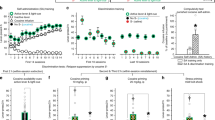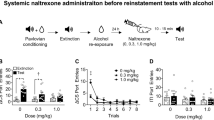The amygdala links neutral stimuli with the agony of overcoming drug addiction.
Abstract
The habitual behaviour of many opiate addicts means that the aversive symptoms of drug withdrawal are frequently experienced in specific environments1. Stimuli in these environments acquire some of the negative affective properties of opiate withdrawal through pavlovian conditioning, and subsequent exposure to these stimuli alone can then elicit a conditioned withdrawal response that is often associated with drug craving, drug seeking, and relapse back to compulsive drug use after a long abstinence1,2. We show here that selective excitotoxic lesions of the basolateral amygdala, part of the limbic forebrain, prevent the development of conditioned withdrawal in morphine-dependent rats.
This is a preview of subscription content, access via your institution
Access options
Subscribe to this journal
Receive 51 print issues and online access
$199.00 per year
only $3.90 per issue
Buy this article
- Purchase on Springer Link
- Instant access to full article PDF
Prices may be subject to local taxes which are calculated during checkout

Similar content being viewed by others
References
Wikler, A. Arch. Gen. Psychiatry 28, 611–616 (1973).
O'Brien, C. P., Testa, T., O'Brien, T. J., Brady, J. P. & Wells, B. Science 195, 1000–1002 (1977).
Koob, G. F. & Le Moal, M. Science 278, 52–58 (1997).
Schulteis, G. & Koob, G. F. Neurochem. Res. 21, 1437–1454 (1996).
Koob, G. F., Wall, T. L. & Bloom, F. E. Psychopharmacology 98, 530 –534 (1989).
Whitelaw, R. B., Markou, A., Robbins, T. W. & Everitt, B. J. Psychopharmacology 127, 213–224 (1996).
Everitt, B. J. et al. Ann. NY Acad. Sci. 877, 412– 438 (1999).
Baldwin, H. R. & Koob, G. F. Neuropsychopharmacology 8, 15–21 (1993).
Everitt, B. J., Cardinal, R. N., Hall, J., Parkinson, J. & Robbins, T. W. in The Amygdala: A Functional Analysis (ed. Aggleton, J.) (Wiley, New York, in the press).
Aston-Jones, G., Delfs, J. M., Druhan, J. & Zhu, Y. Ann. NY Acad. Sci. 877, 486–498 ( 1999).
Groenewegen, H. J., Wright, C. I. & Beijer, A. V. J. Progr. Brain Res. 107, 485–511 (1996).
Schulteis, G., Markou, A., Gold, L. H., Stinus, L. & Koob, G. F. J. Pharmacol. Exp. Ther. 271, 1391–1398 (1994).
Author information
Authors and Affiliations
Corresponding author
Rights and permissions
About this article
Cite this article
Schulteis, G., Ahmed, S., Morse, A. et al. Conditioning and opiate withdrawal. Nature 405, 1013–1014 (2000). https://doi.org/10.1038/35016630
Issue Date:
DOI: https://doi.org/10.1038/35016630
Comments
By submitting a comment you agree to abide by our Terms and Community Guidelines. If you find something abusive or that does not comply with our terms or guidelines please flag it as inappropriate.



